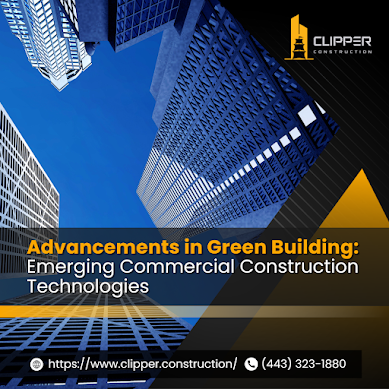What Emerging Commercial Construction Technologies Are Improving Green Building Practices?
The Role of Technology in Advancing Green Construction
Green construction practices are becoming increasingly important with the growing awareness and concern about sustainability in the industry. To meet the increasing demand for sustainable buildings and reduce the negative environmental impact of construction, technologies are emerging to help improve green building practices.
Technological advancements are revolutionizing the way we
design, construct, and operate buildings. From energy-efficient materials to
renewable energy systems, the integration of new technologies is providing
numerous benefits for businesses, the environment, and society. The role of
technology in advancing green construction practices is crucial to achieving a
sustainable future.
Understanding Green Building Practices
Green building practices are designed to reduce the
negative impacts of construction on the environment and promote sustainability.
To understand the importance of green building practices, it is essential to
have an overview of green building concepts and their benefits.
Green building practices involve the use of
energy-efficient construction materials, sustainable site planning, renewable
energy systems, and improved indoor air quality to create buildings that reduce
environmental harm and improve occupant health and well-being. The benefits of
green building for businesses and the environment are vast, including reduced
energy costs, reduced carbon footprint, increased property value, and improved
occupant satisfaction and health.
However, implementing green building practices can be
challenging, especially with the many industry standards, regulations, and
codes that need to be followed. The initial cost of implementing green building
practices may also be a deterrent for some stakeholders.
Advancements in Green Building: Exploring Emerging Commercial Construction
Technologies
Emerging
commercial construction technologies have the potential to revolutionize the
industry, both in terms of cost and energy savings. Here are some of the most
promising technologies that you should know about:
1. Building Information Modeling (BIM)
BIM is an advanced digital technology that allows
architects and engineers to create 3D models of buildings, using detailed
information about materials, dimensions, and other key parameters. With BIM,
constructors can optimize building designs for maximum energy efficiency,
reduce construction times and costs, and minimize waste.
2. Drone Surveys
Drones are increasingly being used in commercial
construction projects to inspect the worksite, collect data and provide aerial
photography and videography. This technology provides accurate and reliable
data that saves time and costs while ensuring worker safety on-site.
3. Prefabrication
Prefabrication involves the off-site assembly of
modular building components, offering the potential for significant cost
savings and shorter construction times. This methodology can lead to reduced
material waste and less noise pollution compared to traditional construction
techniques.
4. Smart Building Systems
Smart building systems use advanced technologies like
sensors and automation to optimize energy use and enhance building performance.
Intelligent HVAC systems, lighting controls and water-saving devices can make
buildings more efficient, reduce energy costs, and improve occupant comfort.
5. Solar Energy
The use of solar energy in commercial buildings is an
emerging technology that has the potential to significantly reduce energy costs
and environmental impact. Solar panels installed on the roof of the building
can capture energy with the possibility of creating an additional source of
income through net metering, connecting to the electric grid, and providing surplus
energy to the utility company.
Emerging commercial construction technologies present a
range of promising opportunities to reduce costs and promote future energy
savings. By staying up-to-date with the latest trends and innovations,
constructors can optimize methods, save time, and positively impact the
environment.
Key Benefits of Incorporating Emerging Technologies
To overcome the challenges of implementing green building
practices, emerging technologies are being developed to help improve green
building practices. Incorporating these technologies can provide a range of
benefits, including energy efficiency, cost savings, improved indoor air
quality, and enhanced building lifecycle management and maintenance.
Energy Efficiency and Reduced Carbon Footprint
One critical benefit of incorporating emerging technologies
in green building practices is the significant reduction of energy consumption
and carbon footprint. Technologies such as high-performance windows, green
roofs, and programmable thermostats are designed to reduce energy consumption
and CO2 emissions during the building's comfortable or operational life.
According to the US Green Building Council’s Green Building
Impact Report, green buildings have 19% lower annual energy consumption, 35%
lower carbon dioxide emissions, and 50% less water usage compared to
traditional buildings.
Cost Savings and Long-Term Economic Benefits
Another important benefit of incorporating emerging
technologies in green building practices is the significant cost savings and
long-term economic benefits. Although the initial cost of implementing green
building practices and technologies may be higher, the long-term economic
benefits such as reduced energy consumption and water usage, increased property
value, and improved occupant satisfaction can provide a substantial return on
investment.
Improved Indoor Air Quality and Occupant Wellbeing
Indoor air quality is another critical factor that affects
building occupants' well-being and health. Emerging technologies such as
advanced air filtration systems, chemical-free insulation, and green cleaning
products can improve indoor air quality and reduce the risk of respiratory
problems and other health issues related to poor air quality.
Enhanced Building Lifecycle Management and Maintenance
Finally, incorporating emerging technologies in green
building practices can improve building lifecycle management and maintenance.
Technologies such as building automation systems, predictive maintenance, and
facility management software can provide real-time data, allowing stakeholders
to monitor and optimize building performance, reducing costs and minimizing the
environmental impact of building operations.
Conclusion
In conclusion, it's clear that emerging commercial
construction technologies are changing the game when it comes to green building
practices. Through the use of innovative materials, improved energy efficiency,
and enhanced building automation systems, builders are now able to create
buildings that are not only eco-friendly but also save owners money in
the long run. While not all of these technologies are perfect, they are taking
important strides toward making construction more sustainable and
environmentally friendly. As we continue to see more developments in this area,
it's exciting to imagine a world where all buildings are constructed with these
green practices in mind.

